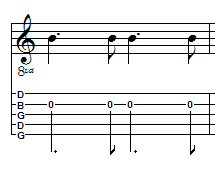
Clawhammer banjo uses a lot--no, a whole lot--of left hand technique. While we are busily striking down on each beat with our basic motion, there are several ways to slip notes in between those beats through use of left hand techniques.
First, let's discuss the whole notion of "between-the-beats." In essence, we have said that the beat is kept by our downstrokes; you'll recall:

To count notes played between those beats, we simply say "and" after each beat. Thus, we can have eight notes per measure, counted as shown in the next piece of tablature. Note that consecutive eighth notes are connected by a "beam." In the second measure below, we've mixed quarter notes and eighth notes (which gives us the same rhythm you hear in the children's song One Little, Two Little, Three Little Syllables):



(You can download this--and all these videos--by simply right-clicking and saving.)
Note that in the first measure, we're then playing the first string open as a single note on the next beat, while in the second measure, we're using a brush. This technique can be--and is--used on any string, of course.
We also play pull-offs on strings that have not been struck with the right hand. Consider this rhythmic lick that Pete Seeger called the "Rufus Crisp Lick" in honor of the man from whom he learned:

(You can download this video file directly with this link: crisp.mp4)
For ease, I usually use my middle finger for the pull-offs in this lick. BTW, did you happen to notice that the video looks virtually identical to the one just above it? That's because the only difference between pulling off a struck string and some other string is what the right hand is doing! Pretty cool,, eh?

Again, we've mixed the tab to show both single string play and alternating brushes. When playing it slowly for the video, I have exaggerated the motion; try not to move so far from the fingerboard when playing!
Similar to pull-offs, hammer-ons are done on all the strings:

Now, Let's mix some hammer-ons and pull-offs:

Sorta simple & cool, eh?

Now let's mix some pull-offs, hammer-ons, and slides together! Here is part of the well known tune Cripple Creek:
